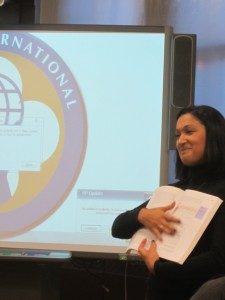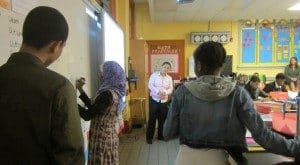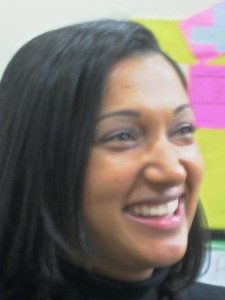First Stop of the Magical Mastery Tour: Bronx International High School
CompetencyWorks Blog

This article is part of a series of case studies of schools in New York City. For the full story, start with my overview of the Magical Mastery Tour and the three biggest takeaways. You can also read the report on Carroll Gardens School for Innovation.
Inspiring. I know no other word to describe the students and staff at Bronx International High School (BxIHS). Arrived from all around the world, the 400+ BxIHS students come to the school with hope, drive, curiosity, creativity…and little or no English.
Designed as a high school to serve new immigrants, BxIHS “accepts students who score at or below the 20th percentile on the Language Assessment Battery (LAB-R) and have been in the United States fewer than four years.” Students enter with a wide range of academic experiences behind them, some having spent little or no time in a formal education setting.
Regardless of background, the two things all the students share is a desire to learn English and to complete high school. Staff members, many of whom were English language learners at one time in their own lives, work collaboratively and joyfully in an “outcomes” approach to ensure that students reach proficiency in language/literacy, content, and skills.
A Peek Inside the Classroom

The first classroom I visited at BxIHS was Luincys Fernandez’s ninth grade science class, which focused on biochemistry. The unit they were studying was The Truth about Epidemics, specifically Ebola and Chikungunya (a virus many of the students from the Dominican Republic have had to deal with).
That day, students were focused on the outcome, “describe and explain the life cycle of a virus.” Students were working in small groups, reading an article about viruses. Ferndandez walked around the classroom, outlining how to annotate the text as she did.
“Circle the words we don’t know. Write questions you have along the side.”
In this way, she coached them on building literacy skills within the discipline of science. At the end of the day, students wrote out what they knew about viruses, which provided an opportunity for them to write and for Fernandez to assess how students were proceeding in understanding the material. At one point, Fernandez took out one of her old textbooks to show how she had marked up the book in her own process of “having a conversation with the text.
On the wall were the expectations for proficient and highly proficient. Proficient was based on explaining four aspects of viruses: 1) the virus structure; 2) the host and virus relationship; 3) the human body and viruses (including harmless viruses, response of immune systems, and pathogenic viruses); and 4) the spread of viruses. Highly proficient had the additional expectation of describing and explaining the life cycle of a virus, including attachment, entry, replication, assembly, and lysis and release.
Yet there was much more information on the walls to help students make connections and study how to be learners. In one corner were many of the academic terms students were expected to be comfortable using and applying: compare and contrast, review, summarize, discuss, evaluate, annotate, identify, explain, justify, describe, demonstrate, illustrate, and show. On another wall, a poster highlighting career exploration suggested places to work and occupations organized by career clusters where students could apply science skills. Another wall had student-generated questions organized by disciplines to help students make connections across the curriculum: Where do these viruses come from? Why are some viruses dangerous and others are not? What will happen to a virus if there is no host? How can you tell if a virus is harmful or not? How are scientists applying their knowledge to find a cure for these viruses? Which countries are affected by these viruses? How will we know which information is right? Are the viruses affecting the same number of people? Can these viruses affect the economy of a country? What are the mortality and survival rates of these viruses?
I had the most fun reading the huge list of questions generated by students about their research project on epidemics (information that would later serve as the basis for the performance assessment): Who is our audience for our presentation? Why aren’t we talking about other diseases? Where did you get this idea?
All of these illustrations outlined the process of students beginning to own their learning and to build the skills to manage it effectively.
Five Design Principles
As one of the nineteen schools in in the Internationals Network for Public Schools, BxIHS is designed around five principles:
- Heterogeneity and Collaboration: Diverse group of students work together and with their teachers to optimize learning. Meaningful work with those of different backgrounds, academic preparedness, and language skills helps each student to develop socially, academically, and linguistically.
- Language and Content Integration: Language skills develop most effectively in context and emerge most naturally in purposeful, language-rich, experiential, and interdisciplinary study. Consequently, each teacher acts as a language teacher within the context of his/her curriculum, and there are no stand-alone ESL or bilingual classes.
- Localized Autonomy with Responsibility: Students, teachers, and schools are empowered to make decisions that maximize student outcomes.
- One Learning Model for All: Like students, teachers and principals collaborate and learn from each other to improve their skills and support each other.
- Schools Beyond Four Walls: Student growth and outcomes are enhanced through experiential learning. Significant experience outside of the classroom motivates students and enhances their capacity to participate in society by extending their language base and developing their social and cultural sophistication.
Although not all INPS schools are competency-based, it’s easy to see how they could become so with the emphasis on empowerment, autonomy, learning, and collaboration.
Outcomes: Creating a Language of Learning
The educators at BxIHS use the language of outcomes-based to describe their model (referred to in shorthand as “outcomes”).
They have three sets of outcomes that organize learning: content, skill (by discipline), and language/literacy. Calibration among teachers focuses primarily on content and skill outcomes within each discipline, with an upcoming effort to strengthen teachers’ abilities across the curriculum to support English language arts.
Melvin Damaolao, a math teacher and member of the Coordinating Council, described the process of converting to an outcomes-based structure: “When we started on our path to outcomes-based education seven years ago, the first thing we needed to focus on was the philosophy about how outcomes can drive learning. The first big mind shift that a teacher learns to ask is, ‘How do I know where kids are?’ The next big step is to be explicit about what we want students to learn.”

The clarity of what students are expected to learn—and why—was evident in all the classrooms I visited. For example, in Marilo Cuyacot’s math class, a sign on the wall said:
Mathematically proficient students will:
- Make sense of problems and persevere in solving them
- Reason abstractly and quantitatively
- Construct viable arguments and critique the reasoning of others
- Model with mathematics
- Use appropriate tools strategically
- Attend to precision
- Look and make use of structure
- Look for and express regularity in repeated reasoning
Many similar lists could be found throughout the school, all of them directing students toward their specific outcomes.
Steps to Building an Outcomes-Based Infrastructure
The transition to this outcomes-based format began seven years ago, starting with the science department. To help with the the process, BxIHS worked with Marc Siciliano, a science teacher and STEM coach who had gained expertise in competency-based learning at Chicago’s Young Women’s Charter Leadership School.
After Principal Joaquin Vega researched the outcomes-based approach, he visited YWCLS in Chicago, and subsequently strategically and methodically rolled out this teaching philosophy over a four-year period, making Bronx International High School the first school in NYC to implement outcomes-based learning. Fernandez and Leah McConaughey, then ninth and tenth grade biology teachers, were the first teachers to work on outcomes-based learning, literally using pen and paper. As this was an enormous shift from how all teachers were assessed and how they graded their students, they held workshops, had extensive and continual professional development, and secured a coach with experience in outcomes-based learning to work regularly with the entire staff on campus, though only the science team was asked to employ outcomes-based mastery during the first year. This allowed the staff to understand the shift while the science team lead in the work. In the second year, the entire science department and one grade team were asked to use outcomes based on their preparedness. In year three, all (three) of the ninth/tenth grade teams, along with the science team, were using outcomes. By the end of the third year, they were able to philosophically reach all of the staff, thus creating an expectation for the entire school to implement outcomes based learning school-wide in the fourth year.
As Fernandez explained the process, “We created intensive workshops for teachers on writing outcomes and indicators that are aligned with our understanding of highly proficient and proficient. The workshops guided teachers step by step on how to use standards to create outcomes. It was critical that our staff know how to delineate between highly proficient and proficient in assessing outcomes.”
BxIHS didn’t just stop with creating the outcomes-based infrastructure. They also wanted to make sure that their instructional model would be highly engaging, support students taking ownership of their learning, and lead to deeper levels of knowledge. Thus they engaged the Buck Institute to help staff build skills in designing projects. (If you haven’t visited their website, please do so. Their resources on how to design project-based learning are absolutely fantastic.)
To this end, BxIHS found that they need to continually invest in fine-tuning the skills of writing outcomes, designing rubrics and calibrating how to determine proficiency. Assistant Principal Megan Williams explained, “When you ritualize practices, they can lose their meaning. Instead of proficiency, a ‘P’ starts to be interpreted as pass. An ‘N’ becomes ‘no’ rather than the powerful ‘not yet.’ As a school, we need to make sure we understand why we do what we do.”
Damaolao described it as such, “As new staff enter the school and as best practices become routines, it is important to revisit the core skills needed for outcomes-based learning. This year, we are planning on having a workshop on how to write outcomes to build common understanding and fine-tune our skills.” He emphasized, “The most important thing is norming among teachers by looking at student work. Our teachers calibrate assessment within disciplines.”
BxIHS hires many of its teachers through the I-Start program. Most of the teachers have experience speaking another language or living/working in another country. The program is designed as a fast-track to a teaching credential, with teachers spending a full year in the classroom, even working during their own coursework after school or in the summer. This allows BxIHS to help new teachers learn their approach to outcomes and student-centered instruction under the mentorship of another teacher.
Pacing in a Student-Centered Environment
When the focus is on content coverage, as is now the case in schools across the country, pacing can be a challenge—especially in a student-centered or personalized environment like that of BxIHS.
As Damaolao characterized it: “Last year we felt the pressure of coverage. This year we joined the New York Performance Standards Consortium and our students only have to take the New York State English Regents. Even though we aren’t being driven by the Regents exams, we still have to cover Common Core. We teach standards through the lens of project-based learning. That’s how we make sure students are learning the process skills they are going to need to succeed when they graduate. However, projects take more time. The only way we can do both is to focus the ninth and tenth grades on the essential skills or power standards.”

(For others interested in the issue about time, depth of learning, and coverage of standards, check out David Ruff’s piece Thoughts on Grain Size and Oliver Grenham’s post Is There Enough Time for Learning?)
Fernandez built on the issue of covering the standards by adding, “In a student-centered approach, we are not frontloading the curriculum. We see what kids know and don’t know, and what they want to do. Our kids are at different levels, so one of our most important goals is to teach skills to do the work by themselves. In science, we focus on annotations, predictions, and inferences. This means that we may slow down to go deeper in an issue because the students are highly engaged. We are investing in strengthening students’ process skills even if we aren’t covering as much content.” She continued, “The next-generation learning science standards focus more on skills, not content. It’s opening up new possibilities for how we can help students learn the skills of science without the pressure of coverage of content.”
Language and Literacy in a Competency-Based Framework
Although students at BxIHS come from a range of academic backgrounds, the one thing they all share is a desire to learn English. Thus, BxIHS is designed with language and literacy emphasized across the curriculum, with all teachers including language outcomes as well as content outcomes in the design of their units. All teachers emphasize strategies for reading in their discipline, and focus on making connections for students. As students demonstrate proficiency in the outcomes in language, teachers update Jump Rope, the grading information system.
Including language and literacy outcomes across the curriculum is a practice that would help any school serving large populations of low-income, lesser-educated families. Learning how to use academic language, expanding Lexiles, and incorporating reading comprehension strategies across the disciplines is a powerful strategy for preparing students for college and careers.
Designing for Differentiation
It’s hard for me to wrap my mind around how BxIHS manages to support students accessing high school curriculum when they may be entering high school with only elementary school experience—and are trying to learn English all at the same time.
So how do they do it? By designing for differentiation.
BxIHS focuses on getting students up to the tenth-grade level before moving on to higher level curriculum, even if it takes some three years to move on to the eleventh grade. The ninth and tenth grades are organized into three teams of students, each with a set of four teachers (one from each discipline). Teachers plan together and discuss how to better support students who are struggling. Most classes are heterogenous, with teachers preparing for differentiation and personalized interventions. For example, teachers will prepare three different reading levels for one topic. Assessment is differentiated as well, so that students are assessed based on the level of their reading, writing, and math skills.
Damaolao explained, “In math, we use ‘asynchronous learning’ so that students learn at their own pace.” While in New York, I heard this term used several times to describe self-paced learning, whether it is online or not. At BxIHS, asynchronous learning is organized around packets, stations, and just-in-time assessment. In addition, approximately one-third of the students (those with the lowest math skills) have a special period to build up their basic numeracy skills.
Students Owning Their Education
Student agency and the process skills they need in order to manage their own learning are at the heart of BxIHS’s culture and instructional approach. Fernandez emphasized, “We make it absolutely clear to students what the outcomes are and how they are going to be assessed. When we start a unit, we walk students through the activity packets and have explicit discussions about the outcomes, the criteria, and how the assignments will help them learn the skills, as well as how they will be assessed. We keep track of the evidence of their learning. Students can look at the grading information system Jump Rope to see their progress and what they are missing.”
Students are encouraged to do self-assessments and peer assessments before turning assignments into teachers. This helps them become familiar with the criteria outlined in the rubrics and to learn to critique their own work, and also reinforces the culture of learning.
Focus of School Improvement Efforts
In order to continue growing and developing within these standards, the BxIHS Coordinating Council has set four areas of focus:
- Transitioning to performance-based assessment tests (PBAT) and project-based learning.
- Aligning skills school-wide and across disciplines. Everyone will be teaching the same skills (including English) and supporting each other, though the evidence will be different for each class.
- Creating workshops for teachers (especially new teachers, to ensure fidelity in writing outcomes, using rubrics, designing project-based units, and performance assessment).
- Making sure assessments are aligned with outcomes, and that calibration among teachers in assessing proficient and highly proficient is universal.
BxIHS recently joined the New York Performance Standards Consortium (Consortium) as it strengthens its system of performance assessments based on seven components. (Interestingly, the NYPSC rubrics indicate competent as less-than-proficient. However, the term isn’t important; it’s the details and levels of knowledge in the rubrics that are. The Consortium is a leader in performance assessments.) They are well on their way to putting all the significant elements together that make up a high-quality competency-based school.
This is a school that never stops improving. It may have a targeted student population, but its insights, practices, and professionalism have lessons for us all.